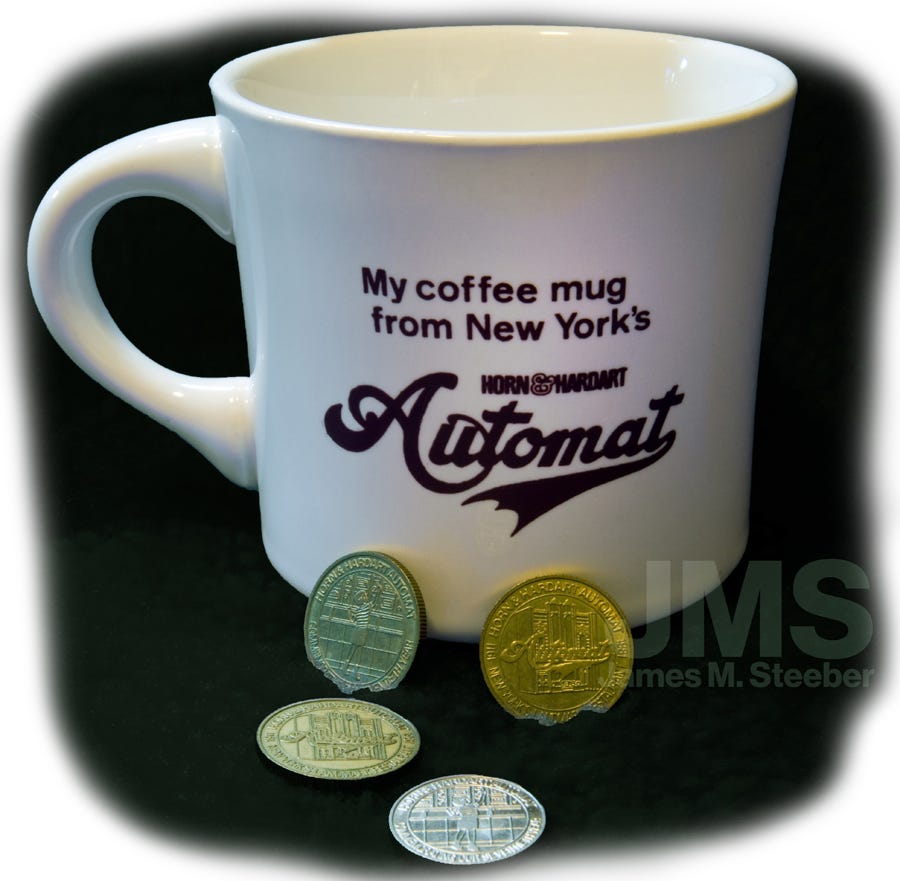The recent release of Lisa Hurwitz’s The Automat movie reminded me about nickels – the kind that used to buy a cup of coffee or a ride on the New York City Subway, years before I came around. My father emigrated to the United States several years after World War II, as a “displaced person” – a refugee. One of his early fascinations was the Automat (of the numerous Automats which dotted New York). Specifically, there was the nickel-changer lady (of which Mel Brooks speaks lovingly in the film) who, either had a doppelganger at every Automat or was employed, perhaps, at the big Automat on Times Square (in recent decades a Burger King that would never belie its secret as having once been a large and elegant place). “It was incredible,” he told me. “You could give her any combination of change and without looking she would reach down and produce exactly the right number of nickels.” Nickels were the official currency of the Automat.
Ah, but the ancient memories are sweet – not of saving money but of having the formula of life remaining simple. It is easier to conceive of a nickel cup rather than a $2.75 cup, even if average earnings have increased by a factor of ten and then some, since that price change. Serving yourself from a machine means not even having to ask, and that is part of the joy of city life.
The Automat’s last gasp came in April 1991. The new 99-year lease that had recently been signed for 42nd Street & Third Avenue didn’t save it, and the site became a Gap store which remains and even looks from the outside a little like the last Automat.
The spirit of the concept also lives, only in more disparate ways. The Pret a Manger (“ready to eat”) chain in New York, imported from London, features mainly items (some of them still hot) that can be grabbed off the shelf. Coffee, like the Automat, is self-served. Given that the little entrees and sandwiches don’t even have to be requested, the Automat concept goes on there – only at a higher price and with no great rooms in which to bask and linger. You still have to wait in line to pay someone, and the waxen beakers are behind the counter. On the other hand, you probably can refill your coffee to go – something that the clever machinery of the Automat wouldn’t have allowed without more nickels.
At Trader Joe’s (about six in Manhattan) the dairy and other perishable shelves are stocked from behind so that food isn’t exposed to room temperature, from truck to selection. That happens at Whole Foods as well, but the prices at the latter are of a wider field. I think of the Automat as milk magically refreshes itself on the shelf. In the tradition of nickels, the price for milk has recently been held to $1.29 per quart – bucking the current trend of dramatically raising the price of staples. Trader Joe’s wins an Automat Prize, not just in the sense of preserving the lower price but in the sense of seeking to protect the customer from the vagaries of the outside.
There is Le Pain Quotidien, which operates at several locations in Manhattan (and more around the world). The idea, originating in Brussels some thirty years ago, is to provide what we now know as organic food, at big common tables in a kind of breezy fashion. Like at the Automat there is pride in food quality and consistency while keeping prices medium-low. You may end up setting squarely in front of a perfect stranger, just like at the Automat. This restaurant is not aimed at the poor, but someone with a basic income can manage it and feel that the experience will be dependably good. The servers are known to be friendly, and the food has taste, from salad to desert. Two people can split a pot of coffee for a nominal price. It works. Pain Quotidien, in my opinion, gets an Automat Award.
Throughout the last throes of the Automat, its properties were gradually sold off to a collection of fast-food outlets. Many of them became Burger Kings. Even there a certain eerie Automat tradition continues. A customer may order from a tall electronic screen and find what are still a few low-cost items that probably equate the amount of food you’d get in the Horn & Hardart side dishes – including sandwiches costing under $3.00. You swipe your card, and the machine transmits your order to the counter where, minutes later your number is called, and you are handed a bag. Only you and the server know what’s in that bag. It’s discrete and easy and is a descendent of the Automat principal that those with little money still need to eat something – even something pretty good. Burger King gets an Automat Award.
Other fast-food corporations have offered smaller items too, and though the novelty and beauty, not to mention the mechanical satisfaction, of the Automat are missing from the scene now, the need to serve the public and in a sense the need to take care of it continues.
The nickel-changing magicians-of-the-coin have retired and died, but the magic they offered and the sense of life to which they were connected still jangles.


